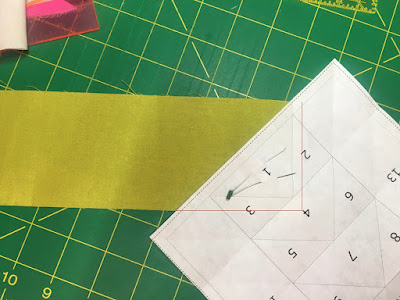We'll start with Block 1.
Foundation piecing is pretty much "sew by numbers", so we'll start with section 1 on your diagram and add section 2.
Reduce your stitch length. I think mine is about 14 stitches per inch. This will make removing the paper in the end SO much easier.
1. Place a 3" fabric strip the color of section 1 RIGHT SIDE DOWN. This is the only time you will have your fabric this way.
2. Place the pattern with the printed side up on top of the fabric overlapping just enough to ensure that you have at least 1/4" on both straight sides. The red line shows where the fabric edges are under the pattern.
I like to pin the first fabric section to the pattern to avoid it shifting when I move everything over to the machine.
3. Cut the green (section 1) fabric along the diagonal a little outside the edge of the pattern. You will trim everything at the end. (I forgot to take a photo of this part)
4. Fold the pattern along the folded line between section 1 and section 2. You should be able to see section 2 faintly through the paper or, if not, at least your fold lines.
5. Lay a strip of background fabric (the color of section 2) RIGHT SIDE UP. I like to do this on the sewing machine so I don't have to move things and risk shifting the fabric. The background fabric strips will be very long in the beginning. If you find it too unwieldy you can cut them in half but don't cut them too short because using strips of fabric is what helps us not waste.
6. Place your pattern (with section 1 pinned in place), on top of the fabric as below. The section 1 (green) and section 2 (white) fabrics will be right sides together. You can remove the pins at this point but hold on to the fabric. Shifting is your enemy.
The blue lines are the seam lines of section 2. The red line is the edge of the background fabric strip.
Be sure to leave enough space all around for a seam allowance.
7. Carefully open the pattern back up and slide everything under the needle. Be careful not to move the fabric or accidentally fold something under.
Sew along the seam line between section 1 and section 2. Do not sew beyond the line. You can backstitch on each end if you like.
Back on the cutting mat, fold the pattern back along the seam you just sewed.
Trim the seam allowance to 1/4" using your ruler or an add-a-quarter ruler.
Open the pattern back up and press.
Voila! You've sewn your first seam!
We're going to continue just like this, following the numbers and the pattern for fabric colors if you're using the fabric from the pattern.
If you have questions, contact me or, better yet, join the
Facebook group because others may have the same question and everyone will be able to see my answer.

%20%20copy.jpg)






































